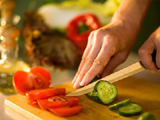Consciousness and health
Infusing consciousness
Abstract
A life replete with spirituality would need an infusion of consciousness in all our little acts to make them progressively perfect. This would develop harmony in the mind as well as in the body.
The other day a Muslim farmer from Bangladesh came to a busy hospital clinic in India and told his doctor that he had brought some molasses prepared by him. He narrated that while he was preparing the molasses for the doctor, he was constantly invoking Allah so that the preparation would be perfect. He was in fact infusing consciousness in the material he was preparing. Everyone in that consulting room acknowledged his sincerity and for a moment all divisions based on religion, caste or country disappeared.
I remember that as a young doctor, I used to feel anguished when at times young married Indian ladies used to tell me that the men in the household preferred having food cooked by the women in the family rather than servants. I used to think that the males were too chauvinistic and dealt with women in a way that was not in consonance with modern times. After many years of medical practice, I realised that the food cooked by a lady of the household had her consciousness in it, wherein she aspired that her husband and children would be fit and healthy with the food she prepared — something that no servant could do. Since then, whenever I conduct personality development programmes for women, I take time to explain why cooking has to be done consciously. In India, where it is a custom for many working women to employ servants for cooking, I tell the women to do at least something consciously even if they do not have time for the whole process of cooking —they could at best select the dishes and recipes and preferably cut the vegetables. In parts of eastern India, cutting vegetables is an art as different vegetables are cut in different ways and often the same vegetable is cut differently in the morning and evening. That finesse in the simple act of cutting vegetables shows how doing simple things consciously was a valued cultural asset.
Perhaps, if we want to have a life that is not ascetic yet replete with spirituality, the basic requisite would be to infuse consciousness in all our little acts so as to make them progressively perfect. Each small and trivial act ranging from climbing a staircase to tearing open a sealed envelope can be done consciously. One needs to be conscious not only when one is praying but even during the most mundane acts like sweeping a floor, polishing a shoe or tying a knot. Every act then becomes a conscious offering at the altar of Truth.
Many years back as a tender Boy Scout, I was part of a group in camp where we were playing the game of treasure hunting. We were following the trail of nicely designed paper cuttings which we collected meticulously and stored delicately so as not to be damaged. Even as children we knew that the paper cuttings were consciously and artistically done and needed careful handling. Twenty years afterwards, when I was a Scout Master, I conducted the same game but this time we, the elders, were somewhat casual and in a hurry so we tore to pieces coloured papers to mark the trail. The children too showed scant respect to the paper-cuttings and crumpled them together in their pockets with disdain. They did not enjoy the game with the fervour and excitement we had when we had played the same game years back. It is then I realised that the paper-cuttings should have been consciously designed as was done by our elders when we were children.
The act of doing everything consciously brings us towards perfection and is a great help in developing not only harmony in the mind but also harmony in the body. It not only makes what we want to do beautiful but also instils harmony and grace in our own selves. The Mother describes:
“Going up and down the stairs — you cannot imagine how useful that can be from the point of view of physical culture, if you know how to make use of it. Instead of going up because you are going up and coming down because you are coming down, like any ordinary man, you go up with the consciousness of all the muscles which are working and of making them work harmoniously. You will see. Just try a little, you will see! This means that you can use all the movements of your life for a harmonious development of the body.
“You bend down to pick something up, you stretch up to find something right at the top of a cupboard, you open a door, you close it, you have to go around an obstacle, there are a hundred and one things you do constantly and which you can make use of for your physical culture and which will demonstrate to you that it is the consciousness you put into it which produces the effect, a hundred times more than just the material fact of doing it. So, you choose the method you like best , but you can use the whole of your daily life in this way....To think constantly of the harmony of the body, of the beauty of the movements, of not doing anything that is ungraceful and awkward. You can obtain a rhythm of movement and gesture which is very exceptional (1).”
Reference
1. The Mother. Collected Works of the Mother, Volume 9. Pondicherry: Sri Aurobindo Ashram Trust; 1977, p. 155.
Dr. Soumitra Basu, a practising psychiatrist and member of SAIIIHR, is the Director of a school of psychology, Integral Yoga Psychology. He is also one of the editors of NAMAH.
Share with us (Comments,contributions,opinions)
When reproducing this feature, please credit NAMAH,and give the byline. Please send us cuttings.



